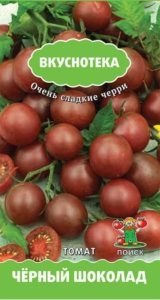The best varieties of black tomatoes (including burgundy, brown, blue): their descriptions and characteristics
To keep your tomato kingdom on the site complete, be sure to plant black varieties of tomatoes. Trust me, it's worth it! Obtained back in the 50s of the twentieth century, these varieties differ not only in their extraordinary appearance, or rather in color, since their leaves and bushes are the most common, but also with a rich tomato taste with a fruity aftertaste, as well as amazing benefits for the human body.
Below is a selection of the most popular varieties and hybrids of black tomatoes!
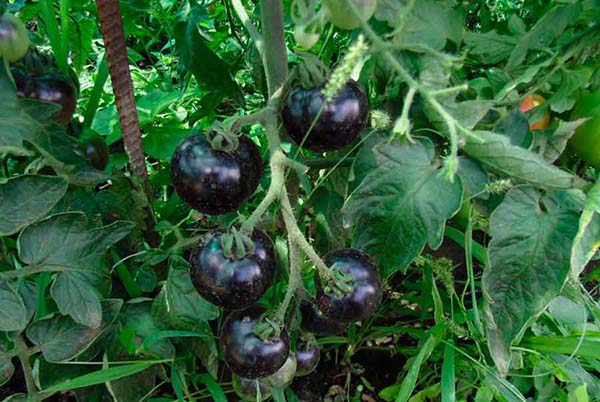
Important! Do not be afraid of black tomatoes, they are not GMOs. Indeed, the blue Indigo tomatoes were bred by crossing wild tomatoes, but precisely crossing, no genetic modifications were carried out with them.
Content
Features and benefits of growing black tomatoes
Note! When they say black tomatoes, then, as a rule, they mean that it is fruits with dark skin color(they are also calledkumato), and red color is still present. Colors maybebrown-burgundy (red), violet-brown, dark cherry (burgundy), with a chocolate sheen .
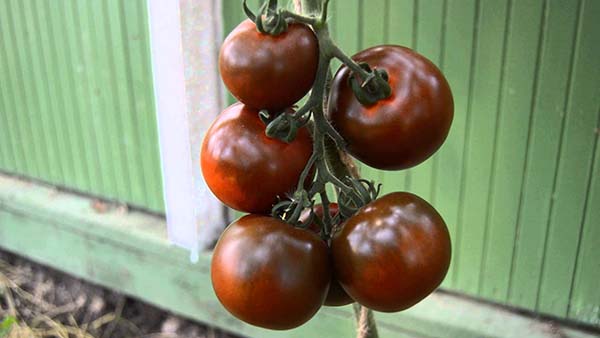
By the way! In some sources all black tomatoes (for example, varieties "Indigo") called exactly bluerather than black (brown).
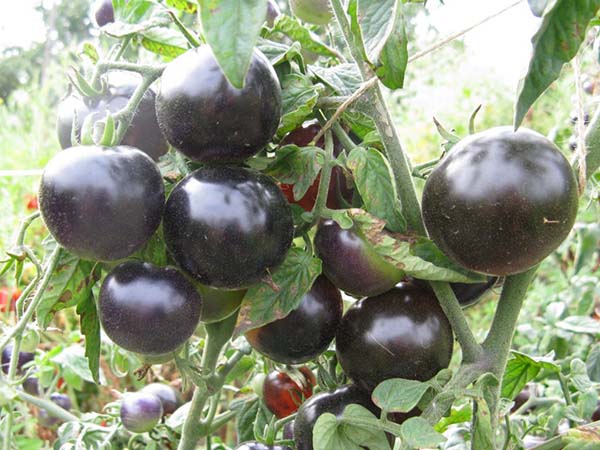
If to yellow tomatoes you can still get used to (although they look very unusual too), especially to strong>pink, then black-fruited tomatoes will always stand out in a special way in the garden.
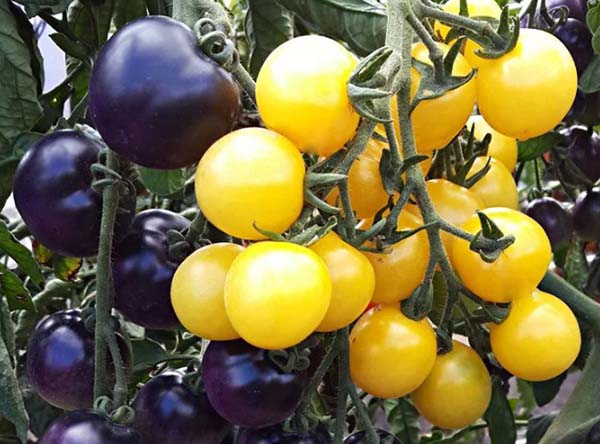
The advantages of growing black tomato varieties are:
- The fruits are almost always very tasty and sweet, so to speak, dessert.
- They have beneficial properties: they have a high content of ascorbic acid, beta-carotene, lycopene, anthocyanin (it is he who provides a dark shade) and other vitamins. Suitable for baby and dietetic food (including older people).
By the way! It is believed, according to some scientists and marketers, that it is chokeberry tomatoes that most effectively (although all tomatoes have a similar effect) increase desire and stimulate an active intimate life of both men and women.
there is even a variety with a telling name "Viagra".
- According to some reviews, they have a fairly high resistance to various tomato diseases, especially late blight. Moreover, completely black (blue) varieties are extremely resistant.
However! According to other sources, black tomatoes, on the contrary, get sick more intensely than tomatoes with a normal, red color.
In any case, black tomatoes have small disadvantages - relatively low productivity and low cold resistance, and increased exactingness to agricultural technology (requires more organic matter, more frequent watering). Also, black varieties are not very suitable for preservation and are, as a rule, just salad.
Finding black tomato seeds is not difficult these days, as they are readily available and sold at any garden store. You just need to choose the most suitable and favorite variety. The description and characteristics of the most popular of them will be given below.
However! It is completely black or, as I also call blue tomatoes, for example, "Indigo rose", "Black bunch", may not be easy to findbut it is quite possible, even more so if you have the Internet.
Video: black and blue tomatoes - the experience of growing several varieties
The best varieties of black tomatoes: top 20 most popular
Note! The list of the best black tomatoes was prepared based on the degree of popularity of the names of varieties and hybrids, an analysis of the reviews of experienced gardeners, as well as the personal opinion of the author.
The most popular and best varieties of black tomatoes are (alphabetically):
By the way! The most common black varieties are the following (according to the degree of popularity): Black Prince, Japanese Truffle and Black Moor - three main hits, and then there are - Chocolate, De Barao Black, Watermelon, Indigo rose, Black bunch F1 (completely black or, as they say, blue tomatoes), Viagra, Marshmallow in chocolate, Gypsy, Chocolate.
Watermelon
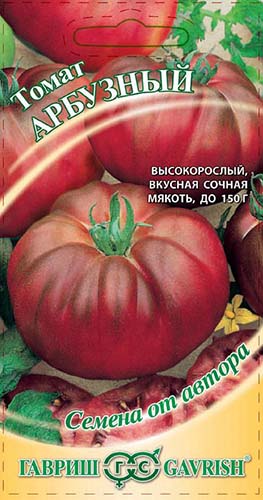
- Medium early (105-110 days from germination to fruiting).
- The plant is indeterminate (over 2.0 m). The first inflorescence is laid above 8-9 leaves, the next ones - after 3 leaves. They are formed into one stem, removing all the "stepsons" and tied to the support. At the end of the growing season, pinch the growing point.
- For film greenhouses.
- Fruits are flat-round, ribbed, multi-chambered.
- Weight - 130-150 g.
- Productivity - 3.0-3.2 kg per plant (4.2-5.6 kg per sq. M).
- The fruits are fleshy, juicy, tasty. Recommended for making fresh salads.
- Resistant to temperature changes.
Viagra
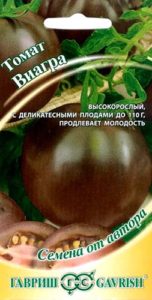
- Mid-season variety (ripening occurs 112 days after full germination)
- The plant is indeterminate, tall.After planting, the plant is formed into one stem, removing all stepsons.
- For growing under film shelters (in a greenhouse).
- Fruits are flat-rounded, slightly ribbed, brown in color, with a dense skin,
- Weight - 110 g.
- Productivity - 10 kg per sq.m.
- The sweet pulp has a rich flavor and strong aroma.
- Resistant to cladosporium and tobacco mosaic virus.
Cherry black
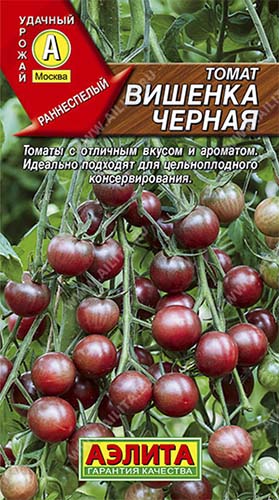
- Early ripe variety, 112 days from germination to fruiting (according to other sources, 100-105 days).
- The plant is indeterminate (with unlimited growth), more than 2 m in height. It is formed into one stem, removing all the “stepchildren”. When the 5th inflorescence is formed, the lower leaves are removed 2-3 times a week. After the formation of 8-10 brushes, the shoot is pinched, leaving 2 leaves above the last brush.
- For growing in film greenhouses.
- Fruits are round, brown in color (violet-brown). The number of nests is 2-3.
- Weight - 18-20 grams.
- Excellent dessert taste, cherry is very sweet and juicy, with a bright, pleasant aroma.
- For the preparation of fresh salads, mouth-watering snacks and colorful canned platter.
- Productivity - 3.5 kg per square meter (according to other sources, 6.5-7 kg).
Pear black
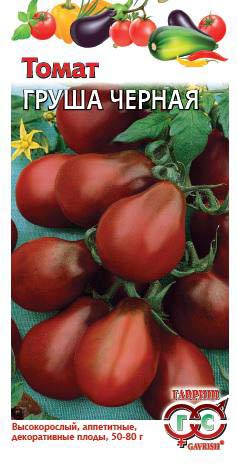
- Mid-season (from germination to ripening 110-115 days).
- The plant is indeterminate (with unlimited growth), up to 2.0 m in height. It is obligatory to tie the plants a few days after planting. They are formed into one stem, removing all the "stepsons" and lower leaves, and also pinch the growing point at the end of the growing season.
- For growing in film and glazed greenhouses, as well as in the open field (with a tie to the stakes).
- Fruits are pear-shaped, brown-burgundy, smooth, dense.
- Weight - 50-80 grams.
- Excellent taste.
- Recommended for fresh consumption and canning.
De Barao black
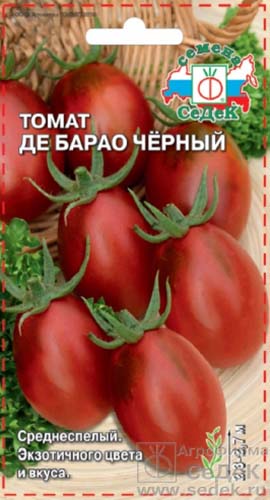
- Mid-season (115-120 days from germination to fruiting) tall variety
- The plant is indeterminate, medium-branched, medium-leafy, 2.3-2.7 m high. Requires garter and pinching. The first inflorescence is laid above 9-11 leaves, the next ones - after 3 leaves.
- For film and glazed greenhouses or for growing in open ground (in more southern regions).
- The fruit is oval-ovate, dense, the color of the unripe fruit is green, with a dark spot, the ripe fruit is violet-brown (dark cherry to black).
- Weight - up to 60 g (according to other sources, 50-70 grams).
- Productivity - up to 8.0 kg / sq.m.
- The taste is excellent. Universal use: recommended for fresh consumption and whole-fruit canning.
- Weakly affected by late blight. The variety is cold-resistant and shade-tolerant.
- It is characterized by long-term fruiting.
Marshmallow in chocolate
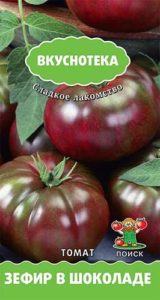
- Mid-season variety.
- The plant is indeterminate, tall, requires shaping and a garter.
- For film greenhouses.
- The fruit is round. The color is red-brown with dark green stripes. The number of nests is 4-6.
- Weight -120-150 g.
- Productivity - 5.7 kg per sq.m.
- The pulp is juicy, greenish in color and excellent taste. For fresh consumption (for salad purposes).
- Resistant to tobacco mosaic virus.
Ivan da Marya
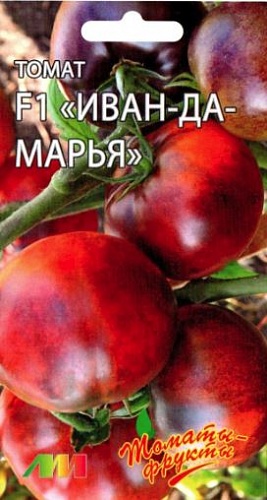
- Early maturing variety. Fruiting in 95-105 days (according to other sources, after 90-110).
- The plant is determinant (semi-determinate), up to 180 cm high, slightly leafy. It is imperative to spawn in one or two stems, cut the top off, leaving 2 leaves above the brush (according to other sources, pinch and shape at the expense of the last stepson).
- For open ground and greenhouses.
- Fruits are dense, round. The unripe fruit has a purple spot, the ripe fruit is reddish brown. The number of nests is 4-6.
- Weight - 200-210 grams.
- Productivity - up to 15 kg per square meter (or up to 5 kg per plant).
- The taste is excellent, the fruit is fleshy. For fresh consumption and for all types of processing.
Indigo Rose
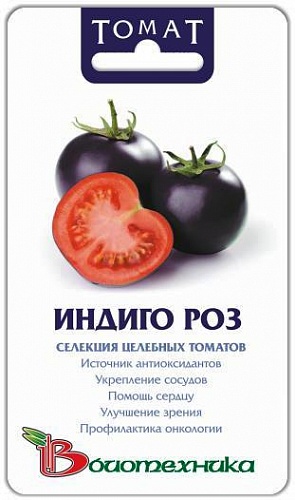
- Mid-season variety (according to other sources, early - 95-100 days).
- The plant is semi-determinate, the bush is medium-sized, 120 cm high.
- Fruits are round, smooth, dark blue-black, looks like a plum (purple outside, red inside).
- Weight - 30-60 grams.
- The fruits are firm and fleshy. The taste of tomatoes is sweet.
- Universal purpose: you can use such interesting fruits both for fresh consumption and in the preparation of various dishes, preservation, salting.
- Resistant to late blight and low temperatures (to frosts down to -5 degrees).
In terms of anthocyanin content, it surpasses blueberries.
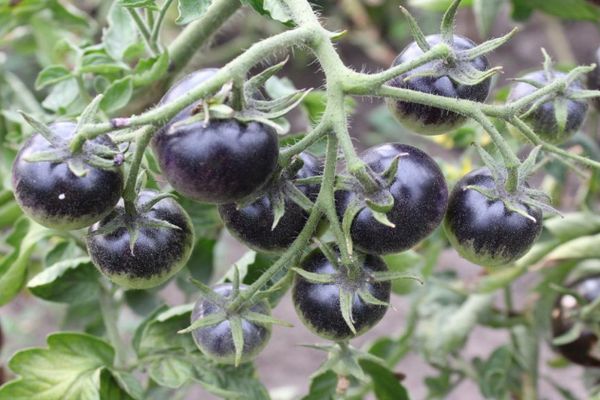
Striped chocolate
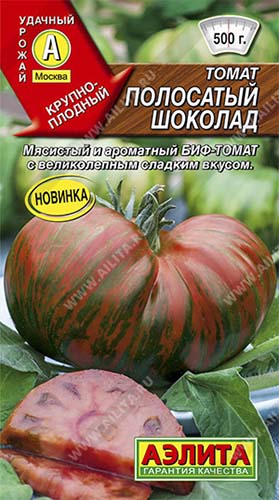
- A mid-season variety, from germination to the beginning of fruiting 115-120 days (according to other sources, 105-110 days).
- Plants are indeterminate, vigorous, 1.5-2 m high. The first inflorescence is formed over 9 leaves, subsequent ones through 3 leaves.
- Fruits are multi-chambered, flat-rounded, weighing 250-350 g, with a smooth glossy surface painted in a deep orange color with very frequent thin green stripes, strokes and strokes.
- Weight - 250-350 g (maximum up to 500 grams).
- Excellent sweet (fruity) taste with light acidity and strong, pleasant aroma. On the cut, it has solid tomato "meat", rather juicy, with a small amount of seeds.
- Ideal for salads.
- Productivity - 8-10 kg per square meter (according to other sources, 17 kg).
Unfortunately, the variety is tolerant to the main complex of tomato diseases.
Paul Robson
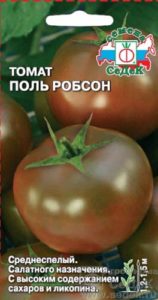
- Mid-season variety (105-110 days).
- The plant is semi-determinate, 1.2-1.5 m high. Requires pinching and garters. There are 3-5 fruits in a bunch.
- For greenhouses, plastic greenhouses and open ground.
- Fruits are flat-round, in the process of ripening the color changes from green to reddish-brown, with a slightly chocolate tint, multi-chambered.
- Weight - 150-250 g (according to other sources, 250-300 grams).
- The fruits are fleshy, with "watermelon pulp", very tasty. High in sugars and lycopene.
- For salad purposes: recommended for fresh consumption.
Brown sugar
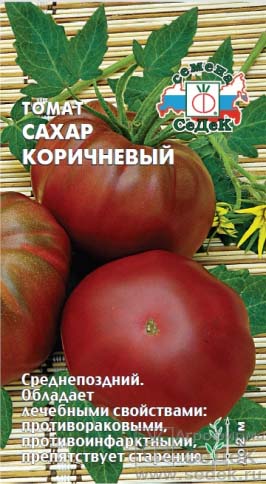
- Medium late variety (115-120 days).
- The plant is indeterminate, tall, up to 2 m high.
- For growing in the open field and under film shelters.
- Fruits are flat-round, maroon and brown. The number of nests is 4-6.
- Weight - 120-150 grams.
- Productivity - 6-7 kg / m2.
- Fleshy fruits, sweet taste.
- For salad purposes: recommended for fresh consumption, home cooking, for obtaining fresh medicinal juice.
- Long-term fruiting.
It has high therapeutic anticancer and anti-infarction properties, prevents aging and belongs to the category of "rejuvenating apples".
Gypsy
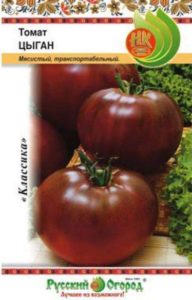
- Mid-season variety.
- The plant is semi-determinate. Requires garter and plant formation. The first inflorescence is laid above 8-9 leaves, the next ones - after 3 leaves.
- For film greenhouses and open ground.
- The fruit is round, medium-silvery. The color of the unripe fruit is green with a large dark green spot at the stalk; the ripe fruit is purple-brown. The number of nests is more than 4.
- Weight - 100-180 grams.
- Productivity - 6.3-6.7 kg per sq.m.
- Good or excellent taste. Recommended for fresh use.
Black bunch F1
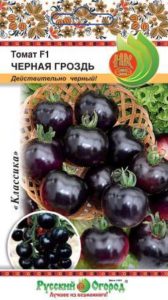
- An early ripe hybrid.
- The plant is indeterminate, about 1.5 meters high.
- For open and closed ground.
- The fruits are plum-shaped, with a rich dark (black, blue) peel.
- Weight - 35-70 g (average - 45 grams).
- The fruits have a pleasant aroma and a plum aftertaste (fruit-plum flavor).
Note! The pigment appears in the skin under the influence of sunlight already at an early stage of maturation. With insufficient sunlight (in greenhouse conditions), the surface of the fruit is less saturated with black.
Black gourmet
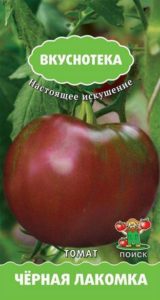
- Mid-season variety. The period from germination to ripening is 110-115 days.
- For film greenhouses.
- The plant is indeterminate, tall, requires shaping and a garter.
- Fruits are round, dense, rich pomegranate (brown) color, with dark red to brown flesh. The number of nests is 4-6.
- Weight - 80-110 g.
- Productivity - 5.6 kg per sq.m.
- Fruits with excellent flavors, tender, juicy, aromatic.
- Salad type: for fresh consumption.
Chernomor
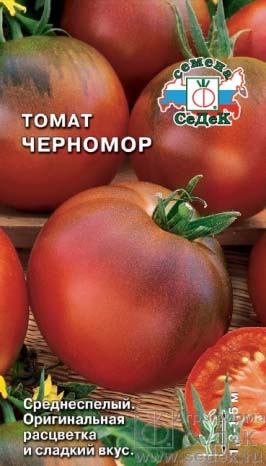
- Mid-season variety (105-110 days).
- The plant is semi-determinate, 1.3-1.5 m high. Requires pinching and garter. There are 3-5 fruits in a bunch.
- For greenhouses, plastic greenhouses and open ground in the southern regions.
- Fruits are flat-round, maroon, multi-chambered.
- Weight from 150-180 to 250-300 grams.
- Productivity - up to 4 kg per plant.
- The fruits are fleshy, juicy, very tasty.
- For salad purposes: recommended for fresh consumption.
Black baron
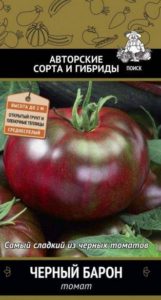
- Mid-season variety. The period from germination to maturation is 120-125 days.
- The plant is indeterminate, the bush is powerful, tall, up to 2 meters high, requires pinching and garters on a support or trellis.
- For film greenhouses and open ground.
- The fruit is flat-round, strongly ribbed, of medium density, brown in color. The number of nests is more than 6.
- Weight 150-250 g.
- Productivity - 6.5 kg per square meter (under film shelters).
- Differs in excellent taste.
- Universal purpose: recommended for fresh consumption, tomato products and canning.
Black moor
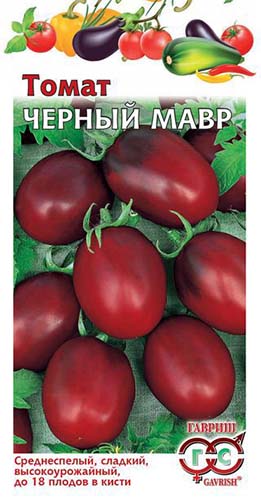
- Mid-season variety (110-115 days from germination to fruiting).
- The plant is indeterminate, medium-sized. The first inflorescence is laid above 8-9 leaves, the next ones - after 3 leaves. Up to 18 fruits can form on one cluster.
- Recommended for glazed and film greenhouses.
- Plum-shaped (ovoid) fruits, dense, smooth, brown-brown, with a dark spot at the stalk,
- Weight - 40-50 grams.
- Productivity - up to 5.3 kg per sq.m. (according to other sources, even up to 6 kg per plant).
- Excellent taste: the pulp is fleshy, juicy, sweet.
- Recommended for fresh consumption, excellent for whole-fruit pickling.
- Susceptible to apical fruit rot during drought.
- The variety is well transported.
Black Prince
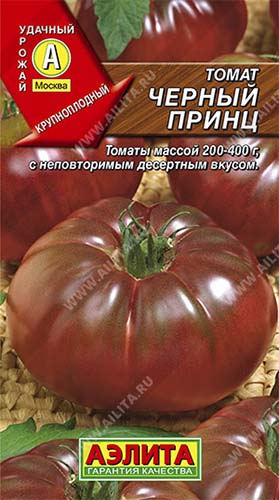
- Mid-season variety (110-115 days from germination to fruiting).
- The plant is determinate, medium-sized, 1-1.5 m high (according to other sources, indeterminate, up to 2 meters high).
- Recommended for open ground (with a tie to stakes), glazed and plastic greenhouses.
- Fruits are flat-round, ribbed, dense, dark red with black tint.
- Weight - 250 g (200-400 grams).
- Productivity - 6-7 kg per sq.m.
- For salad purposes: recommended for fresh consumption. The pulp is fleshy, juicy, sweet (dessert taste).
- It is relatively resistant to late blight.
Black Russian
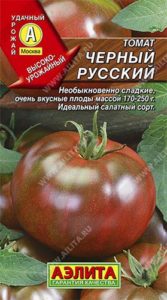
- Mid-season variety (110-115 days from germination to ripening).
- The plant is indeterminate, tall, up to 250 cm high.
- For open ground and film shelters.
- Fruits are flat-rounded, ribbed. The color is unusual - the fruit is black-crimson on top, crimson (or violet-brown) below.
- Weight - 170-250 grams
- Delicious and sweet. Salad destination.
- It is relatively resistant to the main diseases of tomatoes. Possesses good endurance to insufficient light and temperature extremes.
Dark chocolate
- Mid-season variety.
- The plant is indeterminate, tall, requires shaping and a garter. There are 10-12 pieces per brush.
- For film greenhouses.
- Cherry fruits are round, uniformly brown in color with a green spot at the stalk. The number of nests is 2.
- Weight - 20-28 g.
- Productivity - 4.7 kg per sq.m.
- Sweet, with a fruity cherry flavor.
- Salad purpose: for fresh consumption.
F1 chocolate
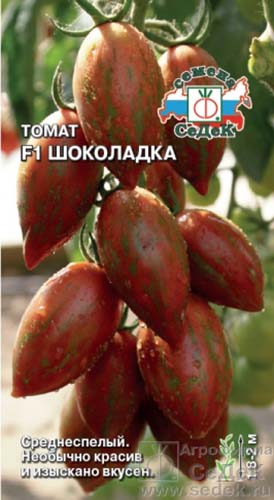
- Mid-season hybrid (115-120 days).
- The plant is indeterminate, 1.8-2 m high, requires a garter and formation. Clusters are simple, long, containing 9-11 fruits.
- For open ground and film shelters.
- Fruits are elongated plum-shaped, brown with dark green stripes.
- Weight - 30-40 g
- Productivity - 6-6.2 kg per sq.m.
- The fruits are juicy and sweet, with an exquisite taste.
- Recommended for fresh consumption and all types of culinary processing.
- Resistant to major diseases and temperature fluctuations.
Chocolate
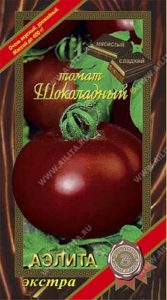
- Medium early variety.
- The plant is semi-determinate, 110-150 cm high.
- Designed for growing in film greenhouses and open field.
- Fruits are multichamber, flat-rounded, brown in color, with orange-brown tender pulp.
- Weight - 200-400 g.
- Productivity - 4.2 kg per sq.m.
- The fruits are delicious, sweet, fleshy.
- Recommended for salads, side dishes, preserves, all kinds of home cooking.
- Resistant to top and root rot.
Japanese truffle black
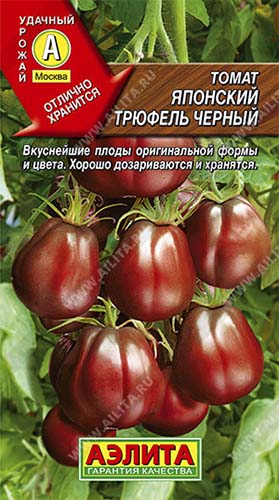
- Mid-season variety, from germination to fruiting 111-115 days.
- The plant is indeterminate, 1.5-2 meters high. Form into 1-2 stems, leaving 4-5 brushes of 5-6 fruits on the stem.
- For greenhouse cultivation (in the middle lane) and open ground (in the south).
- Fruits are black-brown, glossy, very dense. Truffle shape.
- Weight - 100-150 g.
- Productivity - up to 4 kg per plant.
- Fleshy fruits. The taste is sweet with sourness; during storage, the sweetness increases. Universal use: for making salads and canning whole fruits.
- Green fruits, taken at the end of the season, are perfectly ripened and stored until the New Year.
- Protect brushes from creases.
Other varieties of black tomatoes
Of course, there is a sufficient number, albeit a little less well-known, but quite good and proven varieties of black (brown) tomatoes, among which the following can be distinguished:
- Shadowboxing series "Gnome" (has a very rich black tint);
- Bison is black;
- The bull's heart is black;
- Viagra;
- Uncle Styopa;
- Calvados;
- Red coal;
- Creme brulee;
- Crimean black (or Black Crimea);
- Cuban black;
- Monisto chocolate;
- Chocolate cream;
- Icicle is black;
- Carbon;
- Black plum;
- Blueberry (has a very rich black tint);
- Black iceberg;
- Black Pearl;
- Black elephant;
- Chocolate Amazon;
- Chocolate lump;
- Chocolate miracle.
Thus, as you already understood, black tomatoes not only look attractive and unusual, but at the same time they are very pleasant to the taste and healthy. Therefore, if you were also "drawn" to black varieties of tomatoes, now your goal is to choose those options that are more suitable for growing on your site. At the same time, it is important to pay attention to their ripening dates, taste (although they are almost always excellent) and appearance (if you want to have, including fruits of an unusual shape).
Video: the best varieties of black tomatoes


